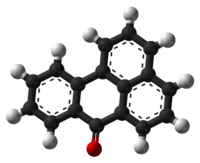Benzanthrone
 | |
 | |
| Names | |
|---|---|
| Other names
benzanthrenone, 1,9-benzanthrone, MS-benzanthrone, mesobenzanthrone, naphtanthrone, 7H-benz(de)anthracene-7-one, 7-oxobenz(de)anthracene | |
| Identifiers | |
| 82-05-3 | |
| 3D model (Jmol) | Interactive image |
| ChEMBL | ChEMBL1607517 |
| ChemSpider | 6442 |
| ECHA InfoCard | 100.001.268 |
| EC Number | 201-393-3 |
| PubChem | 6697 |
| |
| |
| Properties | |
| C17H10O | |
| Molar mass | 230.27 g·mol−1 |
| Appearance | Light yellow to brown-green solid |
| Melting point | 170 °C (338 °F; 443 K) |
| Insoluble | |
| Hazards | |
| S-phrases | S24 S25 S26 S28A S37 S39 S45 |
| Except where otherwise noted, data are given for materials in their standard state (at 25 °C [77 °F], 100 kPa). | |
| | |
| Infobox references | |
Benzanthrone (BZA) is an aromatic hydrocarbon derivate used as a dyestuff intermediate for anthraquinone-based dyes. It has the appearance of a light yellow to brown-green powder with melting point of 170 °C. It is insoluble in water and soluble in alcohol.
It is a basic substance with fluorescent and luminescent properties. It can be used for photosensitization, and as a charge transport material. It is also used in pyrotechnics industry, mainly as a component of some older formulations of green and yellow colored smokes, often together with Vat Yellow 4; its US military specification is MIL-D-50074D.[1]
Safety
Benzanthrone causes itching and burning sensations on exposed skin, together with erythema, dermatitis, and skin pigmentation.[2]
See also
References
- ↑
- ↑ "Appendix A: Benzanthrone". Toxicity of Military Smokes and Obscurants. Volume 3. 1999.
External links
This article is issued from Wikipedia - version of the 12/3/2016. The text is available under the Creative Commons Attribution/Share Alike but additional terms may apply for the media files.